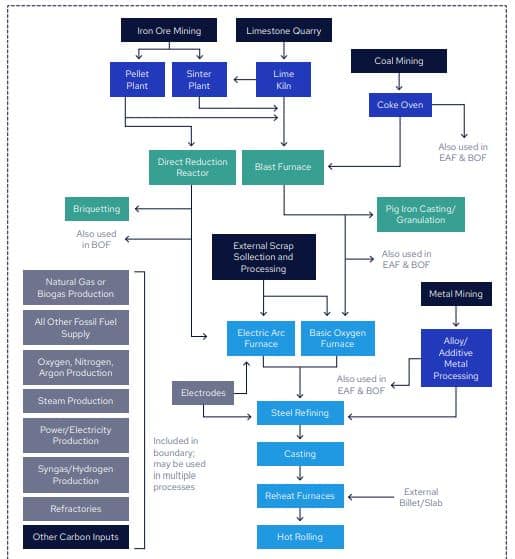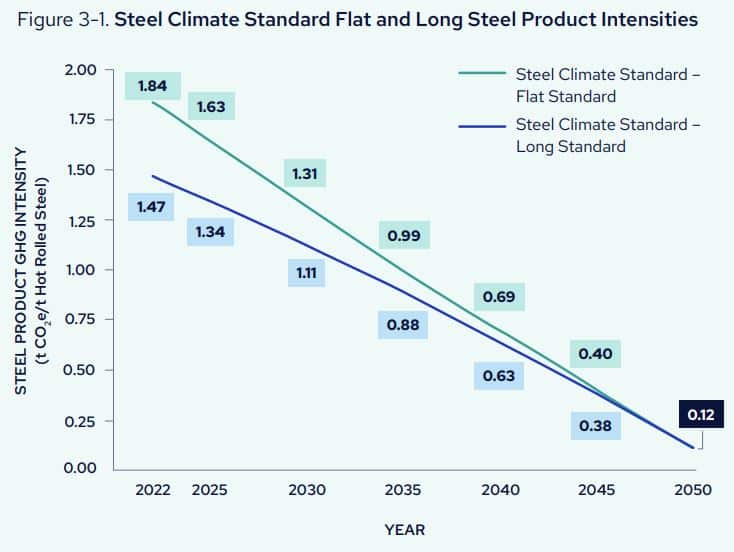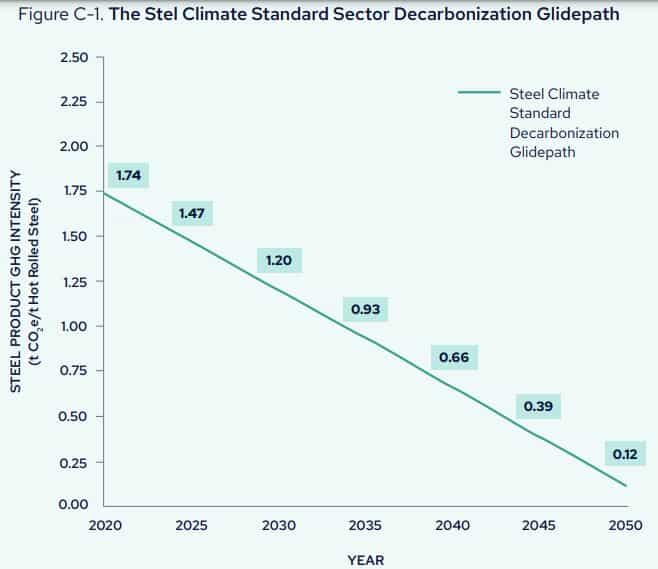The Global Steel Climate Council (GSCC) published the Steel Climate Standard, a global standard for measuring and reporting steel carbon emissions and setting reduction targets.
GSCC is one of several industry groups promoting a global steel standard, leading efforts to reduce steel carbon emissions.
GSCC’s Steel Climate Standard centers on slashing greenhouse gas (GHG) emissions from the global steel industry in line with the Paris Agreement climate goals. It offers a single protocol applicable to all steel producers as it’s not tied to a specific manufacturing technology but requires producers to have science-based GHG emission targets.
A draft version of the Standard was released in April 2023. Comments from stakeholders were incorporated into the final copy recently published.
Here are Our Top 5 Takeaways From the Steel Climate Standard:
1. The Standard sets a system boundary, including all 3 emission sources – Scope 1, 2, and 3.
Setting a comprehensive and consistent boundary is important to ensure that comparisons between steel product carbon intensities are on a like-for-like basis. It also ensures that carbon reduction goals include all relevant carbon-intensive steelmaking processes.
The Steel Climate Standard boundary is fixed, which means participating companies should report all sources included “in boundary” when calculating their product’s carbon intensity. It’s similar to the boundary used by the International Energy Agency in determining lower carbon steel production.
The diagram below shows the processes that must be within the “Steel Climate Standard Boundary” regardless of emission source.

2. The Standard uses these 5 guiding principles in building the framework:
- Scientific – Aligns with IEA forecasts, recent climate research, and Paris Agreement goals for attaining industry-specific emissions cuts by 2050.
- Quantitative – Sets numeric product intensity targets that decrease over time.
- Comprehensive – Creates a complete decarbonization framework with product-based standards and science-based emissions target setting for steelmakers.
- Principled – Lays out a clear vision for steel in a decarbonizing economy employing the process-agnostic approach.
- Transparent – Offers a clear and direct scheme for product certification, verification of emissions targets, and labeling for consumer/end-market use.
3. The Standard has a set of criteria for evaluating and certifying steel products based on carbon intensity
The Steel Climate Standard establishes steel product-based intensity standards (t CO₂e/t hot rolled steel) that differentiate long and flat steel products. Separating the carbon intensity for these products is necessary as they differ in chemical composition.

To certify their products under the Standard, companies should provide their product’s GHG intensity value, with documentation of verified calculations. They should also have science-based emissions targets (SBETs) within 2 years of joining.
Steel producers can certify as many products as they want and can acquire certification at the facility level.
4. Science-based emissions targets that align with the 1.5ºC scenario
Steel companies joining the GSCC’s Steel Climate Standard need to have science-based emissions targets that align with the net zero scenario. This involves, at the minimum, creating both interim or short-term targets (5 – 10 years) and long-term goals.
The Standard provides a clear, step-by-step guide for companies on how to set SBETs. The guideline is based on IEA’s Net Zero by 2050 Roadmap, which allocates a carbon budget for the iron and steel industry. But the Standard takes into account all relevant GHGs, which are excluded in IEA’s pathway.
The Steel Climate Standard also includes a number of iron and steel value chain processes that aren’t part of the IEA scenario. The following chart shows the Standard’s decarbonization glidepath or trajectory, based on steel product GHG intensity.

5. Independent 3rd-party verification is a must
The Standard requires independent third-party verification of product emissions every 3 years and reduction targets every 5 years.
When calculating and reporting Scope 1, 2, and 3 emissions, companies must follow the GHG Protocol Corporate Reporting and Accounting Standard. The Standard also provides a detailed guide for emissions accounting procedures, specifying which established guidelines and standards to comply with. All these calculations must be verified independently.
The Global Standard to Decarbonize Steel
Highlighting the need for a global standard for the steel industry, GSCC Chair Greg Murphy noted that:
“Creating a dual standard would allow high-carbon emissions steel to be prioritized over lower-carbon steel. This would serve to discourage innovation and allow high-carbon steelmakers to postpone making changes in their production process.”
This is what The Steel Climate Standard particularly aims to fix by creating a single, transparent framework that works for all steel producers globally, regardless of the technology they’re using both for high-carbon and low-carbon steel production. Most importantly, it creates a global standard for the industry to help achieve its Paris-aligned emissions reduction goals.


